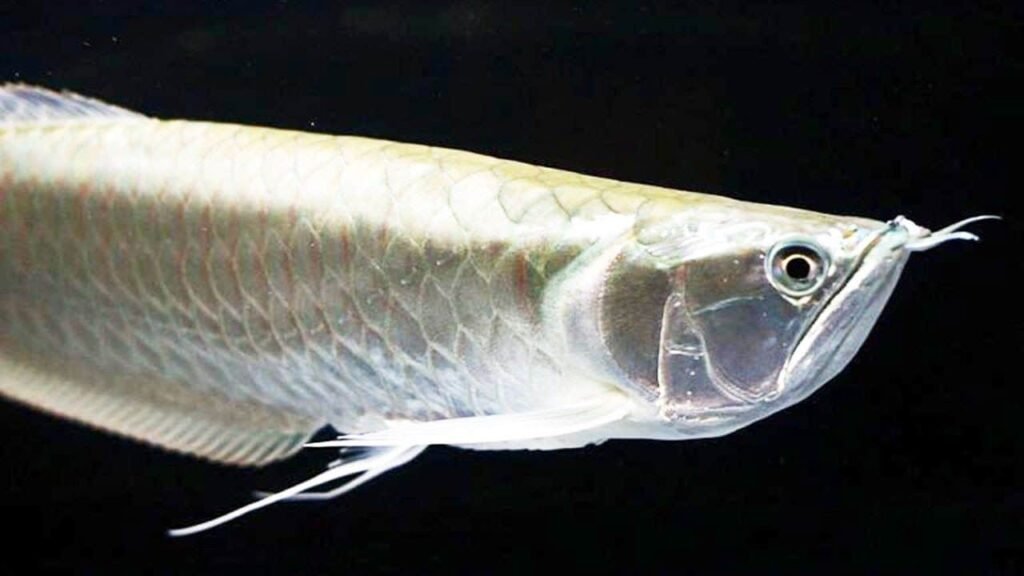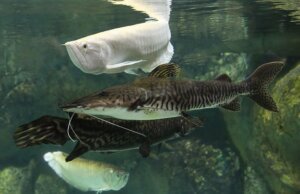The Platinum Arowana is widely recognized as one of the most expensive freshwater fish in the world. Its visually captivating appearance makes it highly sought after by affluent fish keepers who are willing to pay a premium to become its proud owners.
Let’s delve into more details about this tropical species and understand why it commands such a high price.
An overview of the Platinum Arowana (osteoglossum bicirrhosum)
The Platinum Arowana belongs to the Osteoglossidae family. It is a unique threatened fish native to Brazil.

Arowana habitat
The main habitats of this fish are the freshwater rivers, lakes, and ponds in tropical South America. Concentrations can be found in the Amazon River basin, Rupununi, and Oyapock Rivers. It is able to thrive in diverse environments, including flooded forests.
The Arowana is a true carnivore
- NorthFin Arowana Formula is professionally developed to improve the health and well-being of your Arowana or other predatory fish, while naturally enhancing their colors. 3 mm floating sticks are ideal for species requiring higher protein intake.
- Artificial Pigment Free And Has No Added Hormones
- Manufactured In A Cfia /Usda/Fda Registered And Certified Facility In Toronto,Can
Prices pulled from the Amazon Product Advertising API on:
Product prices and availability are accurate as of the date/time indicated and are subject to change. Any price and availability information displayed on [relevant Amazon Site(s), as applicable] at the time of purchase will apply to the purchase of this product.
The Arowana is a hunter, seeking prey of fish, insects and other small animals found on the water surface.
What sets this carnivore fish apart from other hunters is its extraordinary ability to spit to catch prey. They are able to target prey such as insects in low hanging branches and knock them into the water with a squirt of water. This hunting technique is not common among fish. The Archer fish from Australia is another species of fish that uses this technique.
The Arowana is a very fast powerful fish. Its power and the unique hunting technique solidifies its reputation as one of the most amazing and mysterious fish kept by aquarists.
Description of the Platinum Arowana
The Platinum Arowana streamlined body that resembles an eel and its shiny metallic scales that exhibit a mesmerizing pale silver color, make this a very sort after fish.
Its large eyes, oblique mouths, and tapered tail, contribute to its sleek and elegant appearance. In addition, the merging of its dorsal and pectoral fins with the snout, enhances its streamlined look.
The Arowana has two barbels located at its jaw. These barbels allow the fish to sense movements in its surroundings. The fish has a calm confident appearance as it swims gracefully around its tank.
Its slender body is adorned with massive scales that contribute to its majestic appearance and add to its allure. Some scales measure up to an inch in length.
Arowanas have been bred to come in a variety of colors, including silver, blue, and red. Providing enthusiasts with a range of options to choose from.

Arowanas, a threatened species
Due to habitat destruction and illegal mining the Silver Arowana, a close relative of the Platinum Arowana, the fish is under great threat in certain regions. It is considered to be a local delicacy, leading to intense fishing of this species.
To preserve this extraordinary fish and its habitat, there needs to be a concerted effort with conservation and responsible fishing practices.
By preserving this fish’s natural habitat and through responsible fish farming practices, will ensure the survival of this remarkable fish.
Prices pulled from the Amazon Product Advertising API on:
Product prices and availability are accurate as of the date/time indicated and are subject to change. Any price and availability information displayed on [relevant Amazon Site(s), as applicable] at the time of purchase will apply to the purchase of this product.
Why is the Platinum Arowana so sort after?
Fish keepers seek to own this fish as it is a true marvel of nature! Its exceptional hunting technique, impressive physical attributes, confident personality, and adaptability to thrive in diverse freshwater habitats lures people to this fish.
Owning and caring for the Platinum Arowana requires knowledge and experience. However, the rewards of admiring its beauty and being able to watch its unique behaviors make it a worthwhile for the dedicated aquarium enthusiast.
Due to its rarity and beauty, the Platinum Arowana is much sought after aquarium fish. It commands a very high market value with enthusiasts, in some instances, paying more than $300,000 to own this remarkable fish!
Owning this fish isn’t for the light-hearted. Careful attention is required to meet its demanding needs. Arowanas have substantial appetites and require a large and well-equipped tank to thrive.
How long does an Arowana live for?
In captivity, the Platinum Arowana can live for 15 – 21 years or even longer. This depends on the quality of care provided.
Owning a ‘Dragonfish’ brings good luck
The Platinum Arowana is also often referred to as the “Dragonfish”. Its majestic presence, characterized by large scales, extended fins, streamlined body, barbels, and upward-pointing teeth give this fish an appearance and demeanour of a Dragon. Thus, contributing to why this awe-inspiring fish is such a highly sought-after and valuable ornamental fish.
Believed to bring good luck and prosperity among many Asian collectors, this rare fish is a gem among aquatic creatures.
The challenge of keeping Platinum Arowanas
Arowanas have specific care requirements requiring expertise and experience when acquiring and keeping them.
These “monster” fish are capable of growing nearly four feet in length in their natural habitat. Therefore a well-equipped and spacious tank is necessary for their well-being.
Prices pulled from the Amazon Product Advertising API on:
Product prices and availability are accurate as of the date/time indicated and are subject to change. Any price and availability information displayed on [relevant Amazon Site(s), as applicable] at the time of purchase will apply to the purchase of this product.
Tank requirements for keeping Arowanas
Arowanas are demonstrate impressive leaping abilities! Provide a large, wide, and deep tank to accommodate this jumping behavior. Having the correct tank set-up will prevent the fish from excessive contact with the bottom or sides of the tank.
Additional tank reinforcement by covering it with plexiglass or nets will prevent fish jumping out. Due to their robust and aggressive behavior, it is best to only house one Platinum Arowana in the tank.
Due to the fish’s size and strength, it is necessary to have a tank that can hold at least 150 gallons and water with extra-thick glass. Having a sturdy tank will better withstand this magnificent fish’s power and ensure that they are kept safe from injury and stress.
To allow the fish to move around freely without injury, it is better to provide a tank free of obstacles. These fish require lots of open space to swim.
The fish’s beauty can be enhanced by illuminated lights or mirrors.
Arowana Platinum diet and feeding
The Platinum Arowana is a carnivore. In the wild the Arowana is known for capturing prey from the water’s surface.
Keepers of this fish feed fish, crickets, shrimp, and similar live foods. These can be bred by the hobbyist or bought commercially.
It is not always convenient or ideal for these fish to be reliant on live foods. Live foods can also introduce pathogens and diseases into the tank, posing a risk to the fish. So, some hobbyists prefer to feed them on commercial pelleted food. Arowans can be conditioned to eating commercial foods.
When introducing live foods, it is recommended to quarantine them before introducing them to the aquarium.
Arowanas are all individuals and will have their preferences for foods- some fish may be finicky. You may need to experiment with different foods to find out which they will take readily.
Always look for quality when feeding Arowanas. Look for a diet rich in nutrients. By doing so, will ensure a healthy long living fish.
Platinum Arowana tankmates

Due to the size and aggressive behavior of this fish, it is not recommended to keep them in a tank with other fish. They tend to do best when kept on their own. Conflicts and undue stress will result when housed with other species.
Being a solitary predatory fish that is best suited for an exclusive tank setup. Careful considerations and planning need to be made if deciding to include tank-mates.
Look for semi-aggressive and passive species. Consider Oscars, Black Ghost Knife Fish, Pacu, Silver Dollar, Clown Loach, Pleco, larger cichlids, Flying Fox, Redtail Catfish, Tiger Shovel Nose Catfish, and Iridescent Shark.
Interesting traits of the Arowana
Platinum Arowanas have a natural inclination to swim near the water’s surface. They are a apex predators looking for prey on the surface. Some fish in the wild have discovered with bats and snakes in their stomachs. Thus, highlighting their exceptional hunting ability.
Another astonishing trait is its incredible jumping ability. Arowanas can leap up to six feet from the water’s surface to catch bugs, frogs and even birds perched on branches.
Arowanas demonstrate athleticism and adaptability in acquiring food sources.
Breeding Platinum Arowanas
Similar to some other fish species such as the cichlids, the Platinum Arowana is a mouth brooder.
Once the eggs are laid and fertilized, the male carefully collects them into his mouth. He will devote himself entirely to the protection of the eggs. The eggs take about a month to hatch.
During this period, the male Arowana abstains from eating. He devotes himself to focusing solely on nurturing and safeguarding the precious eggs.
The male will continue to protect the fry in his mouth for a further two to three months.
The mouth-brooding behavior of the Arowanas highlight their devotion to protecting their offspring.
The breeding process of this extraordinary species fascinates hobbyists and adds to the lure of keeping this fish.
Gender differences
Telling the difference between male and female Arowanas is very difficult. There are no real visual differences. In order to accurately identify the sex of a breeding pair DNA test is required.
Final thoughts
The Platinum Arowana stands as an exceptional highly desired fish, known for its unique characteristics and unparalleled beauty. Its captivating presence is enhanced by its sleek, flat body, metallic scales, and distinctive features.
This highly valued species captures the attention and admiration of dedicated fish keepers worldwide. It is a true gem among aquatic creatures.
..




